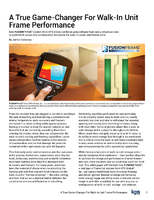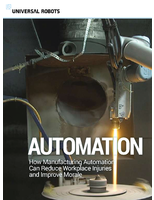x x
Press Release Summary:
x
Original Press Release:
Motion Control is Blowing in the Wind
Motion control technology tunes blade position, damps vibration, and keeps wind turbines turning for optimal power generation
Wind energy is riding the growth curve, with an installed base in excess of 20,000 MW in the United States alone. The 20 kW, 15 m turbines deployed in the 1980s have given way to 2.5 to 3 MW turbines with diameters on the order of 100 m. Size alone doesn't guarantee performance, however; it takes motion control to optimize power generation.
Tuning Blade Pitch
Wind turbines are simply wind-powered generators. Typically a trio of fiberglass or composite blades connects to a hub to form a rotor. That rotor is in turn mounted on a tower that can be 100 m or more high. Wind pressure moves the blades to turn the rotor at 10 or 15 rpm, generating torque. The rotor shaft passes into a nacelle where it connects to a gearbox that converts that speed to 1500 to 1800 Hz, depending on whether the power is for a 50 Hz or 60 Hz power grid. A generator then converts that rotation into current.
In the early days of the technology, the blades were either held in the right position to turn with the wind or switched to a stall position that acted to bring the rotor to a halt. As turbines became more sophisticated, designs began to include actuators to adjust blade pitch to best take advantage of wind speed and direction. The systems were centralized and adjusted all three blades simultaneously, whether to catch wind or to stall. As rotors became larger, however, it was possible for wind conditions to vary from blade to blade, making individual control imperative.
Although hydraulics can accomplish a certain amount of blade-pitch adjustment, it takes motion control to do it effectively, particularly when the goal is to modify position on a realtime basis. "Hydraulics are very good at simplicity," says Raul Martinez, CEO of Sipco MLS (Webster, Texas). "Motion control offers much more sophistication in the controls, the motion profiles, the acceleration/deceleration and so forth." The downside is that they require power, which isn't necessarily available in an emergency situation. That means adding an emergency power source such as a battery or capacitor to the system.
Blade control may be passive ("sleepy") or active (adjusted in realtime). Based on centralized architectures, systems typically control both pitch and azimuthal position. This flexibility is important. Especially for tower heights in excess of 100 m, the structures experience vibration and resonances. This is where realtime blade adjustment can help compensate. "By controlling the blades, we can induce a resonance to balance the machine so we can actually reduce stresses," says Martinez. In essence, they position the blades such that the wind effects damp resonances. "We can reduce harmonics and vibrations being generated in the turbine itself," he adds.
The company is also experimenting with embedding fiber-optic strain sensors in the blade structure to improve wind-load feedback. "We're developing an intelligent actuator that sees loads on blades or resonances of frequencies in the motor or gearbox and tries to balance them," says Martinez. "This is why we think that electronic pitch control is superior to hydraulics, because it has these capabilities for optimization."
Because of the size and mass of the blades, the pitch adjustment systems need a lot of power. A 1.5 MW turbine, for example, requires a motor capable of supplying 2 to 3 kW of normal power and as much as 7 to 10 kW in cases of high acceleration. MLS started with a DC platform but as the controls system has become more sophisticated, the need to reduce inertia and increase responsiveness has driven them to AC components. The systems incorporate a ring gear and a planetary gearbox for a typical reduction ratio of 1000:1 to 2000:1.
Turn, turn, turn
Anything that turns needs some sort of bearing, of course. In addition to the bearings that support the main drive shaft from the hub into the nacelle, bearings need to support the main shaft as it enters the gearbox. Typical designs used spherical roller bearings for main shaft applications but as turbines have grown, so have the bearings. "I don't think spherical roller bearings are the direction to go because the gearboxes are getting so large and the masses getting so high," says Doug Lucas, manager, application engineering in the wind energy business unit at the Timken Co. (Canton, Ohio). Reducing weight is critical; a large mass at the end of a long moment arm can be pushed into resonant oscillation. Even with compensation and damping introduced by blade position, it can be a problem. "You need to come up with more power dense solutions to try to bring these gearboxes down to a more reasonable size," Lucas says. "The bearings we typically end up proposing tend to be tapered roller bearings and cylindrical roller bearings."
With the masses involved, materials choice is key to avoid brinnelling and fracture. One option is case-carburized steel, which is hard on the surface but more ductile toward the center. Damage tends to stay on the surface rather than go all the way through, whereas for case-hardened steel, cracks can propagate through the material more quickly, causing failure.
Which brings up the issue of reliability. Wind systems are utility grade and have to be built for 20- to 30-year lifetimes. Reliability starts with careful design, from properly sizing motors to bearings. "One of the most complex things about wind turbines is the system dynamics," says Lucas. "I think understanding those impacts and the effects on the bearing system can go a long way toward increasing the reliability of these wind turbine gearboxes." The loads in wind turbines tend to go up, for example, so this needs to be taken in account when sizing components.
The environmental conditions involved make ensuring lifetime especially challenging. Depending on location, wind turbines can be exposed to temperature swings greater than -30 deg C to +60 deg C, which means everything from the motors to the bearings to the drive components need to be more robust. "A product that goes into a wind inverter has different temperature requirements than one that goes into a cell phone so many of our devices are rated to -40 deg C to 125 deg C," says Keith Ogboenyiya, product line manager at Texas Instruments (Houston, Texas).
Turbines suffer dust and ice, and marine-based units add the problem of salt corrosion. The height of the towers also makes the units vulnerable to lightning strikes, which means paying careful attention to the grounding of both the drives and the tower.
To help ensure lifetime, suppliers are focusing on smart components that offer diagnostic capabilities, a benefit when the system is 100 m up in the air and may have to be accessed from the outside. Networked systems allow remote software updates. Plug-and-play operation simplifies maintenance when it becomes necessary. Systems need to be easy to operate and maintain, since there is no guarantee that sophisticated technicians will be immediately available to fix a fault and restart operations.
Of course, beyond motion control, wind inverter applications also demand reliable drive and control electronics. "A microcontroller for real-time control [has to perform tasks like] fast analog-to-digital (A/D) sampling and conversions to sample the voltages and current quickly, and have flexible pulse-width-modulation (PWM) generation capabilities for different power topologies," says Zhen Yu, catalog MCU digital power business development manager at Texas Instruments. "Analog and control-oriented peripherals must be complemented with a fast CPU in order to enable a high performance or high efficiency wind inverter application."
Wind turbines grow ever more sophisticated to meet the challenge of efficiency demands. Increasingly, the flexibility and precision of electronic shafting provides the only solution to achieve the performance required. With the global focus on renewable energy, the wind power market stands to be a strong market opportunity for motion control for some time to come.




